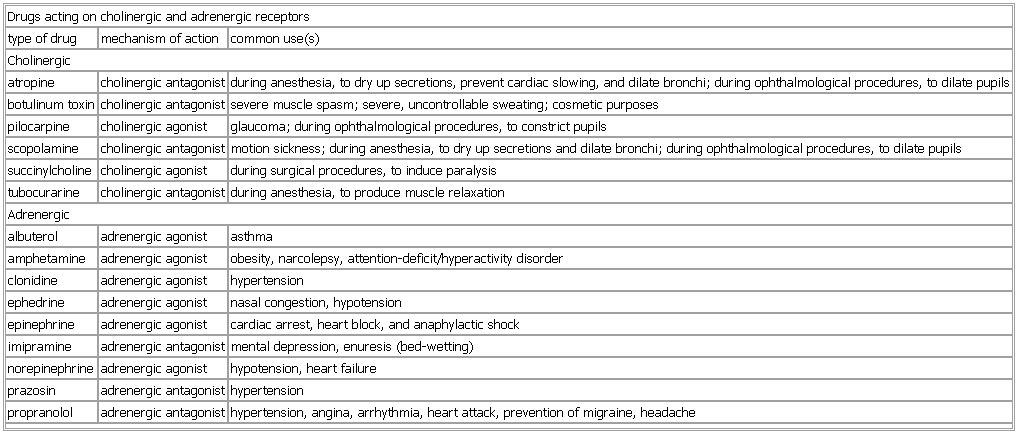Drugs acting on cholinergic and adrenergic receptors
Table
Drugs acting on cholinergic and adrenergic receptors
type of drug mechanism of action common use(s)
Cholinergic
atropine cholinergic antagonist during anesthesia, to dry up secretions, prevent cardiac slowing, and dilate bronchi; during ophthalmological procedures, to dilate pupils
botulinum toxin cholinergic antagonist severe muscle spasm; severe, uncontrollable sweating; cosmetic purposes
pilocarpine cholinergic agonist glaucoma; during ophthalmological procedures, to constrict pupils
scopolamine cholinergic antagonist motion sickness; during anesthesia, to dry up secretions and dilate bronchi; during ophthalmological procedures, to dilate pupils
succinylcholine cholinergic agonist during surgical procedures, to induce paralysis
tubocurarine cholinergic antagonist during anesthesia, to produce muscle relaxation
Adrenergic
albuterol adrenergic agonist asthma
amphetamine adrenergic agonist obesity, narcolepsy, attention-deficit/hyperactivity disorder
clonidine adrenergic agonist hypertension
ephedrine adrenergic agonist nasal congestion, hypotension
epinephrine adrenergic agonist cardiac arrest, heart block, and anaphylactic shock
imipramine adrenergic antagonist mental depression, enuresis (bed-wetting)
norepinephrine adrenergic agonist hypotension, heart failure
prazosin adrenergic antagonist hypertension
propranolol adrenergic antagonist hypertension, angina, arrhythmia, heart attack, prevention of migraine, headache
See as table:

- Würzburg, University of
- Wüst, Georg
- Wüthrich, Kurt
- Wādī al-Jadīd, Al-
- Wādī ash- Shāṭiʾ
- Wādī Ḥalfā
- Wāh
- Wāqidī, al-
- Wāsiṭ
- Wāw
- Wāḥāt al-Khārijah, Al-
- Wāṣil ibn ʿAṭāʾ
- Władysław Anders
- Władysław Broniewski
- Władysław Gomułka
- Władysław Grabski
- Władysław I
- Władysław III Warneńczyk
- Władysław II Jagiełło
- Władysław IV Vasa
- Władysław Orkan
- Władysław Sikorski
- Władysław Stanisław Reymont
- Włocławek
- Wŏnju